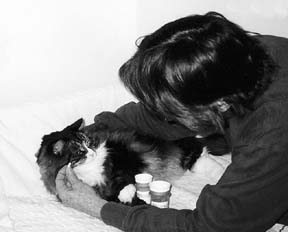Would we want to endure surgery without anesthesia or pain relievers? Would we expect any different response from the cat? Obviously not, says Dr. Charles Short, emeritus professor of anesthesiology and pain management at Cornell Universitys College of Veterinary Medicine, and advisor to the University of Tennessees Center for the Management of Animal Pain.
Pain results from the presence of tissue damage. A wide range of diseases and conditions contribute to tissue responses from sites throughout the body, explains Dr. Short. As tissues are stretched, cut, torn or invaded by cancer, nerve endings are stimulated. Thus begins the process of a painful response. In some cases, it is mild and local, but in others, it can be severe and general. Localized pain may only alter the cats walking pattern, for example; while severe pain significantly influences the entire nervous system. This includes responses at the spinal and cerebral levels.

288
Humans can relate to an injury that causes bruises with or without broken bones, says Dr. Short. We can relate to dental pain or chronic osteoarthritis. So, if we conceive how we feel from the tissue responses resulting from our own pain, we can project that, under similar circumstances, the cat will experience pain, as well. This illustrates why pain management is such an important issue.
Dr. Short says that when managing pain, the first step is to identify the cause of the pain. The resulting treatment is twofold: First, treat the pain with appropriate medications, and then correct the cause, if possible. Dr. Short emphasizes, Pain medications do not cure the cause, they just manage the painful, stressful component. There is a danger in simply addressing the signs of a condition without addressing the condition itself.
Say No to Human Drugs for Cats
Be very careful about giving human medications to cats. Some species tolerate pain medications better than others. The cat may be especially sensitive to human over-the-counter medications, such as Tylenol, says Dr. Short. Without appropriate professional input on dosage and conditions, we cannot even prescribe an aspirin for a cat. It might be fine for you, but it might be unsafe – or even lethal – for your cat.
Communication between owners and veterinarians is essential. In the past, many veterinarians were not offering pain management modalities, says Dr. Short, either because they werent available or because they feared that owners might not want to pay for them. His recommendations:
1. The veterinarian and staff should have a proper dialog with owners regarding the responsibilities of each party with respect to managing the cats pain. All need to communicate enough to understand each others viewpoint and the needs of the patient.
2. Owners must take an active notice of their pets and bring their observations to the veterinarians attention. They need to find out what they should watch for and do. Both sides need to become aware of the comfort level of the patient, especially because cats can hide things very easily.
Dr. Short is concerned that some owners feel that the only time to bring the cat to her veterinarian is for vaccinations. Be aware and observant between veterinarian visits, he says. Do a little homework before you take your pet in. Feel the cat and notice whether it has any uncomfortable places. Take notice if it is eating and eliminating normally, or if its weight has changed.
Pain may be classified as either acute or chronic. Acute pain is short-term – occurring in the first few days after surgery or an injury. It can last from a few days to a month, explains Dr. Short. Chronic pain develops slowly, over time, such as that associated with arthritis and cancer. The cats pain tolerance can affect our ability to recognize its pain, he says. If the pain is acute, the cat will show it more, but if the pain developed slowly, it may have learned to tolerate it.
One of the issues associated with acute, post-surgical pain management is the use of fentanyl patches. This medication must be on the cat for six to 12 hours to be effective, but provides pain relief for at least several days. However, because it is a controlled substance, there may be a problem with sending the cat home with a narcotic attached to its body, especially in a household with children.
Ways to Manage Your Cats Chronic Pain
Dr. Short suggests that when managing chronic pain, the owner should consider ensuring the cats exercise is proportional to its ability, age and weight. He also advises regular teeth cleaning to prevent painful oral conditions, and veterinary care. With respect to senior cats, he says: Be more aware of their nutritional needs and diet. Observe the condition of their teeth, any sore joints, the development of arthritis, or any abdominal pain (signifying GI or kidney problems).

288
What environmental modifications can owners make to help painful cats? Keep your pets surroundings as normal as possible, says Dr. Short. Dont take the cat from a quiet home to a place with lots of noise. Try to protect it from active little kids or a new lively kitten, because the painful older cat may try to respond. Observe any sudden changes in your environment and its effect on the cat.
The American Association of Feline Practitioners (www.aafponline.org/) has outlined several modifications to support the older, arthritic cat, including: carpeted ramps to favorite perching areas, heated bedding and owner assisted grooming. Older cats may be reluctant to climb stairs, so relocating litter pans in more accessible areas and reducing the height of litter pan rims may prevent inappropriate elimination. Weight loss reduces the stress on compromised joints in overweight cats. Alternative therapies should be explored for their potential role in the treatment of chronic pain.
Development of medications has been slower for cats compared with dogs, says Dr. Short. This is because of cats small size, the function of their organs and metabolism (affecting time of uptake), and the fact that some common medications can be toxic to cats. All these factors together make it difficult to determine the proper dosage for cats. Many people dont understand, he continues, that when you look at dogs and cats, the range between the smallest cat to the largest dog is like a baby to a football player. This has made it so complicated to get all the protocols and procedures in place for anesthesia and pain management for cats.
But interest in pain management – with a focus on cats – has been gaining momentum recently. Whats new is that the movement has gotten big enough that people are taking notice of the subject. Over the last three years, the veterinary colleges have shown a major increase in interest in teaching pain management, says Dr. Short.
In 2002, a task force developed a standardized course syllabus for pain management, the first in veterinary medicine, explains Dr. Short. In March of 2003, the American Animal Hospital Association adopted, for the first time, a standard on pain management as part of their standards for hospital accreditation.
This was a huge step forward. The recognition of the pain management discipline culminated in September 2003 with the establishment of the International Veterinary Academy of Pain Management that provides veterinarians a common place to go for information, says Dr. Short.
The cat is not being forgotten, says Dr. Short. There are a number of studies currently underway. Medications are in the pipeline, and appropriate protocols are expected to be developed. In some cases, the studies may determine safe and effective dosage levels of existing medications being used for humans and dogs. Other studies seek to develop new medications or formulations specifically for the cat.
While there is hope for more advanced and effective therapies for cats, the best way to manage your pets pain, says Dr. Short, is to work in partnership with your veterinarian, creating an individualized treatment plan for your cats specific needs.



